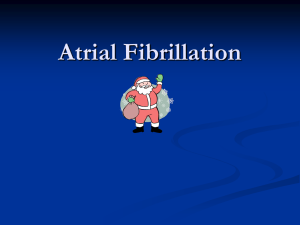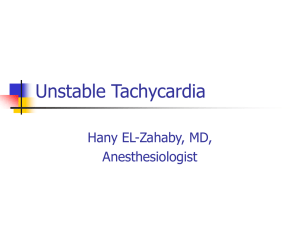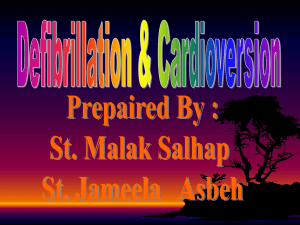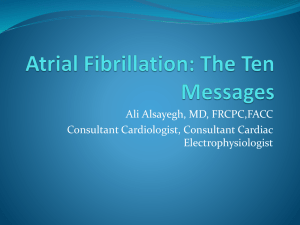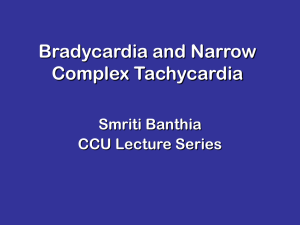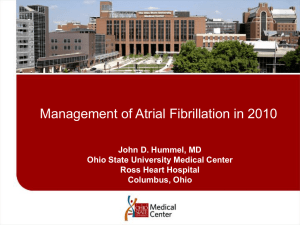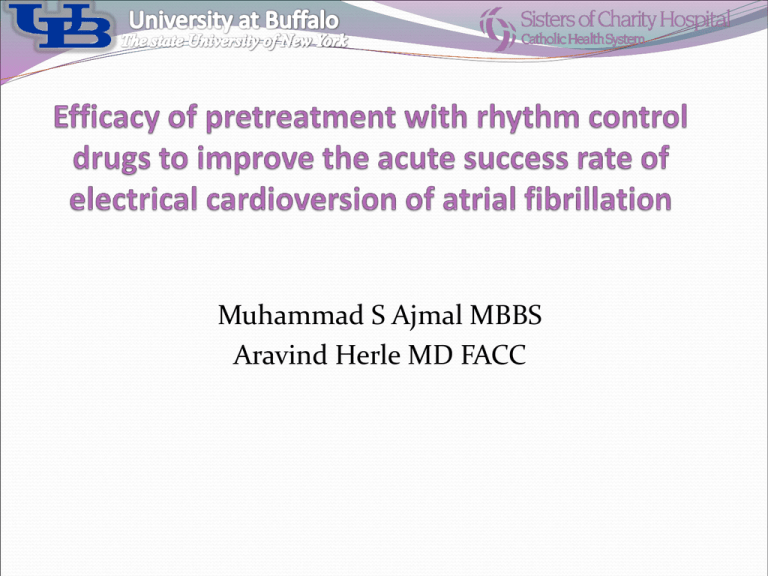
Muhammad S Ajmal MBBS
Aravind Herle MD FACC
Atrial fibrillation (AF)
A supraventricular tachyarrhythmia characterized by
uncoordinated atrial activation with consequent
deterioration of atrial mechanical function.
The estimated prevalence of AF is 0.4% to 1% in the
general population, increasing with age to 8% in
patients older then 80.
2.2 million people in USA and 4.5 million people in
Europe has AF.
Fuster, V. et al. Circulation 2006;114:e257-e354
Clinical manifestations
Available data suggests that quality of life is
considerably impaired in patients with AF compared
to age-matched controls.
Asymptomatic phase.
Subjective symptoms: Fatigue, palpitations, chest
pain, dyspnea, lightheadedness or syncope.
Exacerbation of heart failure.
Embolic complications including Stroke.
Fuster, V. et al. Circulation 2006;114:e257-e354
Management
Strategic objectives:
1. Prevention of thromboembolism.
2. Rate control.
3. Correction of rhythm disturbance.
Prevention of thromboembolism.
Studies have shown increase risk of stroke in
patients with AF.
The
simplest risk assessment scheme is
the CHADS2 score. Studies showed clear
relationship between CHAD2 score and risk of
stroke.
European Heart Journal (2010) 31, 2369-2429
Rate or Rhythm control
Randomized clinical trials have shown rate control to be
at least non- inferior to rhythm control therapies.
Choice
must be individualized, depending on the
symptoms, patient preferences, comorbid conditions, and
the ongoing response to treatment.
Rate control is a reasonable initial therapy for patients
with persistent AF .
European Heart Journal (2010) 31, 2369-2429
Rhythm Control
Rhythm control is preferable in following conditions:
1. Symptomatic AF not responding to rate control.
2. Congestive heart failure.
3. Patient preference to achieve sinus rhythm, specially in
younger population who are intolerant to AF.
4. Unable to tolerate rate control agents.
Rhythm control
Pharmacological cardioversion.
Electrical cardioversion.
Pharmacological cardioversion
Recent meta-analysis of 45 clinical trials, comprising of
12559 patients showed that class 1A,1C and 3 drugs
increase the likelihood of maintaining sinus rhythm but
increase adverse events.
Mortality was low in most studies(0-4.4%) but Class 1A
drugs were associated with increased mortality.
Cochrane Database Syst Rev 2007;4:CD005049
2011 Writing Group Members, et al. Circulation 2011;123:104-123
Electrical cardioversion
Delivery of an electrical shock synchronized with the intrinsic
activity of the heart by sensing the R wave of the EKG to
ensure that electrical stimulation does not occur during the
vulnerable phase of the cardiac cycle.
Performed under light anesthesia with prophylactic anti-
coagulation.
Success rate in literature varies between 70-99% depending
upon the definition of success.
Fuster, V. et al. Circulation 2006;114:e257-e354
Review of Literature
Factors that predispose to AF recurrence:
1. Duration of AF before electrical cardioversion.
2. Number of previous recurrences.
3. Increased left atrial size.
4. Coronary heart disease or pulmonary or mitral valve
disease.
European Heart Journal (2010) 31, 2369-2429
ACC/AHA/ESC Guidelines Regarding
Pharmacological Enhancement of Electrical
Cardioversion.
Pretreatment with Amiodarone, Flecainide, Ibutilide,
Propafenone and Sotalol can be useful to enhance the
success of direct-current cardioversion and prevent
recurrent atrial fibrillation. Class 2A (Level of evidence B).
Efficacy
of Beta blockers, Verapamil, Diltiazem,
Disopyramide, Procainamide or Dofetilide to enhance the
success of direct current cardioversion is uncertain.
Class 2B (Level of evidence C).
Fuster, V. et al. Circulation 2006;114:e257-e354
European Heart Journal (2010) 31, 2369-2429
Review of Literature
The role of Antiarrhythmic drugs to enhance the acute
success rate of electrical cardioversion remains unclear.
No large randomized clinical trials.
Few small trials showed conflicting evidence that
pretreatment with class 1c and class 3 agents enhance
the acute success of electrical cardioversion of AF.
Comparative
efficacy of
pretreatment is unknown.
various
drugs
European Heart Journal (2010) 31, 2369-2429
used
for
Study Objectives:
1. Acute success rate of electrical cardioversion of AF
at Mercy Hospital?
2. Efficacy of pretreatment with rhythm control drugs
to improve the acute success rate of electrical
cardioversion of AF.
3. Compare efficacy of various rhythm control drugs
used for pretreatment.
4. Identify other predictors of successful electrical
cardioversion of AF.
Study Design.
Retrospective chart review.
IRB Approval; Consent waived.
HIPAA compliance.
Inclusion criteria:
All patients who underwent electrical cardioversion for AF
during 2007-10 were included in the study.
Exclusions:
Patients in atrial flutter or any other atrial arrhythmia’s
were excluded from the study.
Study Design
Patients were divided into two groups. One group
received pretreatment with rhythm control drugs before
electrical cardioversion and other group did not.
Rhythm control drugs included class 1c or class 3
Antiarrhythmic drugs.
Pretreament was defined as initiation of rhythm control
drugs any time before the procedure.
Study Design
Patients in
atrial flutter at
time of
cardioversion.
Excluded from
atrial fibrillation
group.
Total cases of electrical
cardioversion at Mercy
Hospital during 2007-10
Patients with atrial
fibrillation that
underwent electrical
cardioversion.
Patients who received
pretreatment.
Successful
cardioversion
Un-successful
cardioversion
Patients who did not
receive pretreatment.
Successful
cardioversion
Un-successful
cardioversion
Study Design
Following additional data was collected about each
patient:
Age.
Sex.
Clinical setting.
Duration of AF.
Persistent or paroxysmal AF.
Hx of Hyperthyroidism.
Hx of COPD.
Study Design
Size of left atrium.
Left ventricular ejection fraction.
Hx of Hypertension.
Anti-coagulation status.
TEE before procedure.
Number of shocks.
Energy settings of the shock.
Baseline Characteristics.
Both groups were closely matched.
Only statistically significant difference was Duration
of AF longer then 6 months in pretreatment group
compared with the other group (83% and 68%
respectively). P=0.0155
Successful electrical cardioversion
Acute conversion to sinus rhythm confirmed by post-
cardioversion EKG.
Maintenance of rhythm for at least 2 hours or until
the patient left the cath lab.
IRAF and sub acute recurrences within first 2 hours
were included as failure of cardioversion.
Hypothetical illustration of
cardioversion failure.
Fuster, V. et al. Circulation 2006;114:e257-e354
Results:
Patients in atrial
flutter
Total cases of electrical cardioversion.
49
304
Excluded from atrial
Patients in atrial fibrillation.
fibrillation group.
255
Patients who received
pretreatment
Patients who did not receive
pretreatment
101
154
Successful
cardioversion
Un-successful
cardioversion
Successful
cardioversion
Un-successful
Cardioversion
89
12
125
29
Results.
Overall success rate of electrical cardioversion of AF at
Mercy Hospital: 84%.
Success rate in patients who received pretreatment:
88%
Success rate in patients with no pretreatment: 81%
This difference was not statistically significant.
(p=0.1647).
Results:
Acute Success rate of electrical cardioversion of
Atrial flutter was 96%.
Success rates of individual Antiarrhythmic drugs
Anti-Arrhythmic
drugs
Patients receiving Un-Successful
pretreatment
cardioversions
Success
rate
Dronedarone
16
5
71%
Amiodarone
25
1
96%
Propafenone
19
0
100%
Sotalol
30
4
87%
Dofetilide
2
0
100%
Flecainide
5
0
100%
Ibutilide
4
2
50%
Efficacy of Dronedarone in pharmacological
enhancement of electrical cardioversion
Dronedarone, a newer class 3 Antiarrhythmic drug had
lower success rate when used for pretreatment
compared with Amiodarone and Propafenone. This
difference was statistically significant. ( P=0.0261 and
P=0.0135 respectively).
Dronedarone sub-group also had a lower success rate
compared with Sotalol, Flecainide and Dofetilide, but the
difference was not statistically significant.
Table 2-3).Baseline characteristics of Patients in Dronedarone and
Amiodarone/Propafenone sub-groups did not show any statistically
significant differences in terms of duration of atrial fibrillation, size of left
atrium and LVEF.
Efficacy of Dronedarone
DAFNE trial showed that in patients with persistent AF,
Dronedarone converted only 5.8% to sinus rhythm (3.1 %
converted with placebo) and did not improve the acute
success rate of electrical cardioversion.
• DIONYSOS trial showed that Dronedarone was inferior to
Amiodarone in preventing recurrence of AF including
unsuccessful electrical cardioversion but was better
tolerated.
Eur Heart J (2003) 24 (16): 1481-1487.
J Am Coll Cardiol, 2009; 54:1089-1095
Other predictors of Successful electrical cardioversion
Factor
Mean Age
Successful
cardioversion
Un-successful
cardioversion
64.65 SD 12.04
62.21 SD 11.38
Male=67% Female Males=70%
33%
Female=30%
Statistical
significance
p=0.5338
Sex
Duration of atrial
fibrillation >6months 69%.
Size of left atrium>4.5
cm
61%.
p=0.8552
68%.
p=1.00
85%.
p=0.0126
LVEF<50%
34%.
36%.
p=0.8528
Hx of COPD
6%.
12%.
p=0.1781
Hx of HTN
94%.
In-patient=31%
Out-patient=69%
p=0.7143
Clinical Setting
93%.
In-patient=34%
Out-patient=66%
Hyperthyroidism
<1%
<1%
p=1.00
Average# of shocks
1.4/Patient
2.51/patient
Energy Settings
194J/Shock
211J/Shock
p=0.7157
Conclusions
Pretreatment with class 1c or 3 Antiarrhythmic drugs
failed to show statistically significant evidence of
enhancing the acute success rate of electrical
cardioversion of AF. But, a confounding bias exist.
Pretreatment
with Dronedarone was inferior to
Amiodarone and Propafenone in improving the acute
success rate of electrical cardioversion of AF.
Size of left atrium is inversely related to the likelihood of
successful electrical cardioversion and this association is
statistically significant.
Limitations of the study
Retrospective study.
Small sample size for each sub-groups.
Limited follow up after electrical cardioversion to
determine the probability of maintenance of sinus
rhythm.
Acknowledgement
Dr. Aravind Herle.
Dr. Khalid J Qazi.
CHS IRB Team.
HIM staff.
Questions
Thank You

